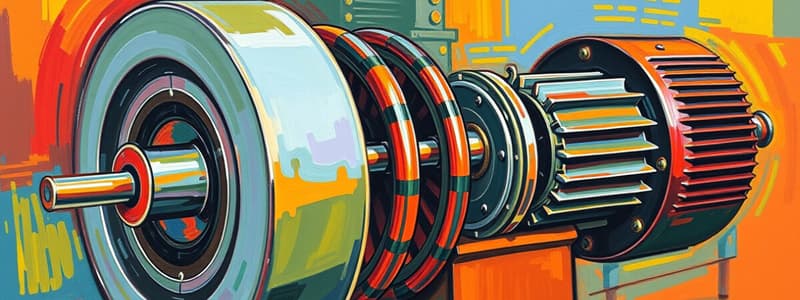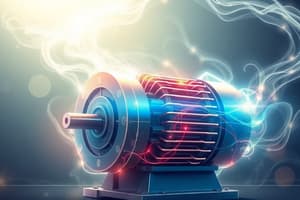Podcast
Questions and Answers
What happens to the torque-slip characteristics as the slip increases in the medium-slip region?
What happens to the torque-slip characteristics as the slip increases in the medium-slip region?
- The torque remains constant regardless of slip.
- The torque becomes directly proportional to slip.
- The characteristics become linear.
- The characteristics become represented by a rectangular hyperbola. (correct)
What is the term used to describe the maximum torque developed by an induction motor?
What is the term used to describe the maximum torque developed by an induction motor?
- Rated torque
- Pull-out torque (correct)
- Starting torque
- Full-load torque
In the high-slip region, what occurs to the torque as the slip increases beyond the maximum torque point?
In the high-slip region, what occurs to the torque as the slip increases beyond the maximum torque point?
- The torque fluctuates irregularly.
- The torque decreases. (correct)
- The torque increases linearly.
- The torque remains constant.
How does adding resistance to the rotor circuit affect the maximum torque of an induction motor?
How does adding resistance to the rotor circuit affect the maximum torque of an induction motor?
What is the typical range of breakdown torque in relation to full-load torque for a 3-phase induction motor?
What is the typical range of breakdown torque in relation to full-load torque for a 3-phase induction motor?
What is the primary reason that an induction motor cannot run at synchronous speed?
What is the primary reason that an induction motor cannot run at synchronous speed?
In an induction motor, what is the term used to describe the difference between the synchronous speed and actual rotor speed?
In an induction motor, what is the term used to describe the difference between the synchronous speed and actual rotor speed?
Which of the following statements about the rotor in an induction motor is true?
Which of the following statements about the rotor in an induction motor is true?
What factor determines the synchronous speed of an induction motor?
What factor determines the synchronous speed of an induction motor?
Which law explains why the rotor of an induction motor rotates in the same direction as the stator's magnetic field?
Which law explains why the rotor of an induction motor rotates in the same direction as the stator's magnetic field?
Why is an induction motor referred to as an asynchronous motor?
Why is an induction motor referred to as an asynchronous motor?
What is the significance of the rotating magnetic field established in an induction motor?
What is the significance of the rotating magnetic field established in an induction motor?
What causes the induced EMF in the rotor of an induction motor?
What causes the induced EMF in the rotor of an induction motor?
What is the main advantage of a three-phase induction motor?
What is the main advantage of a three-phase induction motor?
What does the vector sum of three currents in a balanced three-phase system equal at any instant?
What does the vector sum of three currents in a balanced three-phase system equal at any instant?
In a three-phase induction motor, how are the phases distributed in relation to each other?
In a three-phase induction motor, how are the phases distributed in relation to each other?
What does the resultant flux vector do as it rotates in space at different points?
What does the resultant flux vector do as it rotates in space at different points?
At what point does the resultant flux vector rotate 30 degrees further clockwise?
At what point does the resultant flux vector rotate 30 degrees further clockwise?
What is the resulting magnetic field when considering the value of φR, φY, and φB at any instant?
What is the resulting magnetic field when considering the value of φR, φY, and φB at any instant?
What is the mathematical representation of the magnetic flux produced in each phase?
What is the mathematical representation of the magnetic flux produced in each phase?
Which statement describes the role of balanced supply in a three-phase motor?
Which statement describes the role of balanced supply in a three-phase motor?
What does the per-unit slip in a 3-phase induction motor denote?
What does the per-unit slip in a 3-phase induction motor denote?
How is the rotor frequency of a 3-phase induction motor determined?
How is the rotor frequency of a 3-phase induction motor determined?
At what condition is the rotor frequency equal to the supply frequency in a 3-phase induction motor?
At what condition is the rotor frequency equal to the supply frequency in a 3-phase induction motor?
What happens to the rotor EMF as the slip in a 3-phase induction motor increases?
What happens to the rotor EMF as the slip in a 3-phase induction motor increases?
In a 3-phase induction motor, what is the behavior of the rotor when stationary?
In a 3-phase induction motor, what is the behavior of the rotor when stationary?
What remains constant regardless of the rotor speed in a 3-phase induction motor?
What remains constant regardless of the rotor speed in a 3-phase induction motor?
Which of the following correctly describes the relationship between rotor current frequency and slip?
Which of the following correctly describes the relationship between rotor current frequency and slip?
How is the rotor's reactance treated when analyzing a 3-phase induction motor at standstill condition?
How is the rotor's reactance treated when analyzing a 3-phase induction motor at standstill condition?
What is the slip value when the rotor is stationary?
What is the slip value when the rotor is stationary?
Which factor does NOT affect the torque produced by a three-phase induction motor?
Which factor does NOT affect the torque produced by a three-phase induction motor?
In which region of the torque-slip characteristics does the torque increase proportionally with slip?
In which region of the torque-slip characteristics does the torque increase proportionally with slip?
What is the definition of power factor in the context of an induction motor's rotor circuit?
What is the definition of power factor in the context of an induction motor's rotor circuit?
If the rotor resistance R2 and reactance X2 are constant, how does the torque behave with changing slip?
If the rotor resistance R2 and reactance X2 are constant, how does the torque behave with changing slip?
What happens to the torque when the slip is zero?
What happens to the torque when the slip is zero?
What determines the proportionality of the torque in the torque equation of a three-phase induction motor?
What determines the proportionality of the torque in the torque equation of a three-phase induction motor?
Which statement accurately describes the relationship between stator emf and the flux produced by the stator?
Which statement accurately describes the relationship between stator emf and the flux produced by the stator?
Flashcards are hidden until you start studying
Study Notes
Overview of Three-Phase Induction Motor
- Converts electrical energy into mechanical energy using three-phase AC supply.
- Self-starting design eliminates the need for additional starting devices.
- Widely used due to robustness, cost-effectiveness, and ease of maintenance.
Generation of Rotating Magnetic Field
- Stator consists of windings separated by 120° in space.
- Resultant magnetic field from three currents rotates in space over time.
- Instantaneous flux values for each phase at different time points can be calculated, showcasing the constant non-zero resultant flux.
- Establishment of a rotating magnetic field occurs due to the balanced supply in the three-phase stator winding.
Working Principle
- Stator windings create a rotating magnetic field at synchronous speed when connected to a three-phase AC source.
- Induced EMF in the rotor, caused by the interaction between rotor conductors and the rotating field, generates torque.
- Rotor speed is always less than synchronous speed to ensure continuous EMF induction, defined as slip.
Key Terms in Induction Motor
- Synchronous Speed (NS): Speed of the rotating magnetic field, calculated based on the number of poles (P) and supply frequency (f).
- Slip: The difference between synchronous speed and actual rotor speed; critical for torque generation.
Rotor Frequency and EMF
- Stator current frequency matches supply frequency; rotor current frequency varies based on slip.
- When stationary, rotor behaves like a transformer with short-circuited secondary; induced EMF is directly proportional to slip.
- Induced EMF in rotor is calculated from stator voltage and turns ratio.
Rotor Current and Power Factor
- Rotor circuit reactance remains constant regardless of slip; resistance does not depend on slip either.
- Power factor derived from the ratio of resistance to impedance in the rotor circuit.
Torque Equation of Induction Motor
- Torque produced is proportional to stator flux, rotor current, and power factor of rotor.
- The derived torque equation incorporates synchronous speed, slip, and rotor reactance.
Torque-Slip Characteristics
- Torque varies with slip, showing three distinct regions: low-slip, medium-slip, high-slip.
- Low-Slip Region: Torque is directly proportional to slip, producing a linear relationship near synchronous speed.
- Medium-Slip Region: As slip increases, torque becomes inversely proportional to slip, forming a rectangular hyperbola leading to maximum torque.
- High-Slip Region: Torque decreases past maximum torque point, causing motor slowdown and potential stalling.
- Breakdown torque indicates motor's short-term overloading capacity, typically 2 to 3 times the full-load torque.
Additional Notes
- Adding resistance to the rotor circuit does not alter maximum torque but shifts the slip value at which maximum torque occurs.
- Understanding these dynamics is crucial for effective application and maintenance of three-phase induction motors in various industrial settings.
Studying That Suits You
Use AI to generate personalized quizzes and flashcards to suit your learning preferences.





